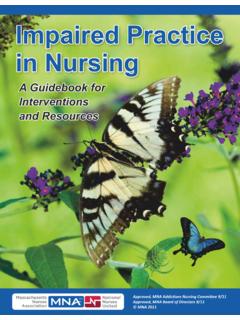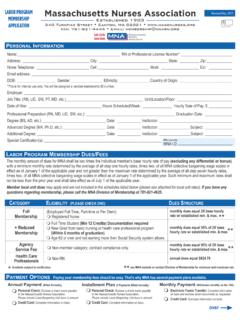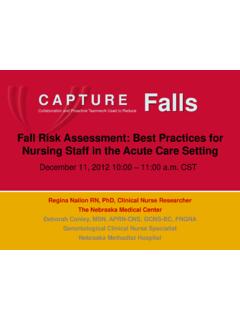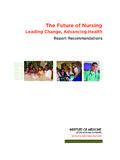Transcription of The Impact of Nurse Staffing on Hospital Costs and Patient ...
1 The Impact of Nurse Staffing on Hospital Costs and Patient Length of Stay: A Systematic Review Petsunee Thungjaroenkul, RN, MS (APPLIED STATISTICS); Greta G. Cummings, PhD, RN; Amanda Embleton, BNSc, RN. Nurs Econ. 2007;25(5):255-265. 2007 Jannetti Publications, Inc. Posted Introduction In an era of restricted health care funding and rising health care Costs , hospitals have been compelled to restructure work environments, attempting to deliver health services at lower Costs without decreasing the quality of care (Heinz, 2004). As a result of restructuring and increasing attention to Costs , many hospitals have chosen to decrease their overall labor pool, including the number of full-time nursing positions (Kunen, 1996;. Norrish & Rundall, 2001), leading to documented significant negative effects to nurses' health, well-being, and ability to provide quality nursing care (Cummings & Estabrooks, 2003).
2 Efforts to enhance operational efficiency have led to changes in Nurse Staffing patterns, decreasing the number of registered nurses (RNs) and replacing them with unlicensed assistive personnel (Barkell, Killinger, & Schultz, 2002). Whether the size and skill of the current health care workforce can adequately meet Patient needs has become a question of growing concern (Norrish & Rundall, 2001). Increased caregiver workload and declining numbers of RNs threaten the quality of Patient care and safety (Needleman, Buerhaus, Mattke, Stewart, & Zelevinsky, 2003). Nurse Staffing patterns are the subject of much discussion in the professional research literature. Several authors examining the effects of reducing RN positions on Patient outcomes report increased Patient mortality (Estabrooks, Midodzi, Cummings, Ricker, & Gio vannetti, 2005; Needleman, Buer haus, Mattke, Stewart, &.)
3 Zelevin sky, 2002; Tourangeau, Giovan netti, Tu, & Wood, 2002); increased rates of failure to rescue (Aiken, Clarke, Sloane, Sochalski, & Silber, 2002); and increased incidence of nosocomial infections, pressure sores, medical errors, and pa tient falls (Cho, Ketefian, Barkauskas, & Smith, 2003; Kovner, Mezey, & Harrington, 2002). Furthermore, findings suggest that increased numbers of RNs increases Patient satisfaction (McGillis Hall, Doran, & Pink, 2004). The availability of RNs and their professional nursing skills may also influence Patient length of stay (LOS) and Hospital Costs . Several researchers analyzed the relationship between Nurse Staffing and LOS. By increasing the number of RNs and providing more RN hours per Patient day, Patient LOS decreased (Flood & Diers, 1988.
4 Needleman et al., 2002; Schultz, Van Servellen, Chang, McNeese-Smith, & Waxenberg, 1998). Lange, Hodge, Olson, Romano, and Kravitz (2004) conducted a systematic review of the effect of Nurse Staffing on Patient outcomes including LOS and Costs , reviewing studies published between 1980 and 2003. However, they did not report the process and search strategy used. Few studies in the Lange and colleagues' review examined the relationship between Nurse Staffing , LOS, and Hospital Costs . Of nine studies showing an effect of Nurse Staffing on Costs , eight were published between the 1980s and early 1990s. No clear recommendations were reported concerning the research design of included studies, or cost and LOS measures, both of which are important for decision making in health care organizations.
5 The systematic review reported in this article builds on Lange and colleagues' review in two ways: (a) it includes studies published be tween 1990 and 2006, and (b) it provides a detailed search strategy for the review process and results from the research literature examining the relationship between RN Staffing levels, Patient LOS, and Hospital Costs . We also present recommendations for effective staff ing and further research in this area. Methods The search strategy was guided by the following research questions: (a) Does RN Staffing affect the cost of care delivered to patients in acute Hospital settings? and (b) Does RN Staffing affect Patient LOS? The data search in cluded five electronic databases (Medline, CINAHL, Health star, Cochrane, ABI/Inform), and manual searching from reference lists of key articles.
6 The search strategy and search terms are provided in Table 1 . Studies relevant to the research questions were included if they met the following six criteria: published between 1990 and 2006; focused on Nurse Staffing and length of stay or Costs ; relevant to care of all patients;. peer-reviewed; use of correlational, experimental, retrospective or ob servation method ologies allowing for a degree of generalizability; and description of the designs and method of data collection to test the relationship between registered Nurse Staffing , length of stay, and Hospital Costs . Studies in nursing homes or that examined other health workforce characteristics, such as medical staff ratios or partnership between nurses and staff in other disciplines, were excluded.
7 Screening The initial electronic search identified 718 titles and study abstracts. Of these, a second re viewer reviewed 80. abstracts to test the initial author decisions regarding inclusion and exclusion criteria. Inter-rater reliability was agreement, with consensus reached on one abstract for a published systematic review. This led to the addition of another exclusion criterion: systematic reviews were excluded unless they examined research questions identical to this review study. Of 718 articles, 89 abstracts were selected using the final inclusion and exclusion criteria. Once 41 duplicate abstracts were removed, 48 abstracts re mained for manuscript retrieval and screening. Forty-six full-text manuscripts were screened as two studies could not be found.
8 Ten of the 46 studies were randomly screened by a second reviewer. Discrepancies in assessments were managed by consensus. Finally, the screening process yielded a total of 17 papers that met the final inclusion criteria. Quality Assessment and Data Extraction The 17 studies were evaluated for methodologic quality. A quality assessment tool guided this process and was adapted from an instrument used in several published systematic reviews (Cummings & Estabrooks, 2003;. Estabrooks et al., 2001; Meijers et al., 2006). Twelve items were designed to assess five features of each study: research design, variable measures, sample, data collection, and data analysis. Each item was scored dichotomously. A total score for each paper ranged from 0 to 12.
9 Studies with scores less than 4 were considered weak studies. Those with scores of 4 to 8 were considered to have moderate strength and those with scores greater than 8 were considered strong studies. Of the 17 papers, 12 studies were evaluated as moderate and 5 studies as strong. Weaknesses in the research included use of retrospective design, nonrandom sampling, and inadequate management of data collection processes. Strengths of the final group of studies were the use of multiple sites and statistical methods for controlling extraneous factors. The following data were then extracted onto a standardized form: authors, year, country, study objectives, population, sample, research design, variable measures, data analysis, study results, and comments.
10 Results A total of 17 articles met the inclusion and exclusion criteria. Characteristics of included studies are summarized in Table 2 . Characteristics of Included Studies Thirteen studies were conducted in the United States. Remaining studies were conducted in Australia, Austria, Canada, and Taiwan. Retrospective re search designs were used most frequently. Some studies combined retrospective and prospective de signs, and few studies used pro spective designs which would offer more detailed cost measurement and more flexibility than retrospective designs. All reviewed studies reported effects of Nurse Staffing on Hospital Costs and/or LOS measures. Twelve studies examined the effect of Nurse Staffing on Hospital Costs . Of these, three studies used total Hospital expenditures obtained from financial reports.










